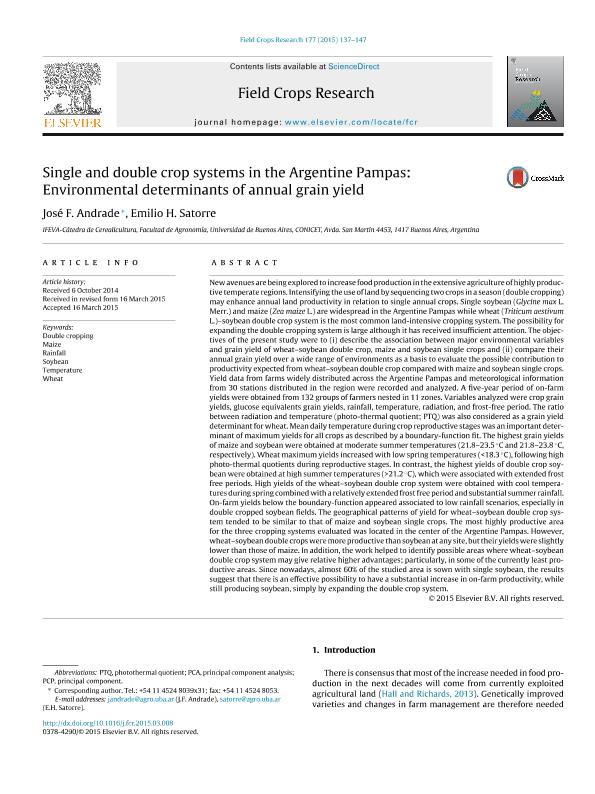Mostrar el registro sencillo del ítem
dc.contributor.author
Andrade, José Francisco

dc.contributor.author
Satorre, Emilio Horacio

dc.date.available
2017-06-02T20:39:04Z
dc.date.issued
2015-06
dc.identifier.citation
Andrade, José Francisco; Satorre, Emilio Horacio; Single and double crop systems in the Argentine Pampas: environmental determinants of annual grain yield; Elsevier Science; Field Crops Research; 177; 6-2015; 137-147
dc.identifier.issn
0378-4290
dc.identifier.uri
http://hdl.handle.net/11336/17429
dc.description.abstract
New avenues are being explored to increase food production in the extensive agriculture of highly productive temperate regions. Intensifying the use of land by sequencing two crops in a season (double cropping) may enhance annual land productivity in relation to single annual crops. Single soybean (Glycine max L. Merr.) and maize (Zea maize L.) are widespread in the Argentine Pampas while wheat (Triticum aestivum L.)–soybean double crop system is the most common land-intensive cropping system. The possibility for expanding the double cropping system is large although it has received insufficient attention. The objectives of the present study were to (i) describe the association between major environmental variables and grain yield of wheat–soybean double crop, maize and soybean single crops and (ii) compare their annual grain yield over a wide range of environments as a basis to evaluate the possible contribution to productivity expected from wheat–soybean double crop compared with maize and soybean single crops. Yield data from farms widely distributed across the Argentine Pampas and meteorological information from 30 stations distributed in the region were recorded and analyzed. A five-year period of on-farm yields were obtained from 132 groups of farmers nested in 11 zones. Variables analyzed were crop grain yields, glucose equivalents grain yields, rainfall, temperature, radiation, and frost-free period. The ratio between radiation and temperature (photo-thermal quotient; PTQ) was also considered as a grain yield determinantfor wheat. Mean daily temperature during crop reproductive stages was an important determinant of maximum yields for all crops as described by a boundary-function fit. The highest grain yields of maize and soybean were obtained at moderate summer temperatures (21.8–23.5 ◦C and 21.8–23.8 ◦C, respectively). Wheat maximum yields increased with low spring temperatures (<18.3 ◦C), following high photo-thermal quotients during reproductive stages. In contrast, the highest yields of double crop soybean were obtained at high summer temperatures (>21.2 ◦C), which were associated with extended frost free periods. High yields of the wheat–soybean double crop system were obtained with cool temperatures during spring combined with a relatively extended frostfree period and substantial summer rainfall. On-farm yields below the boundary-function appeared associated to low rainfall scenarios, especially in double cropped soybean fields. The geographical patterns of yield for wheat–soybean double crop system tended to be similar to that of maize and soybean single crops. The most highly productive area for the three cropping systems evaluated was located in the center of the Argentine Pampas. However, wheat–soybean double crops weremore productive than soybean at any site, buttheir yields were slightly lower than those of maize. In addition, the work helped to identify possible areas where wheat–soybean double crop system may give relative higher advantages; particularly, in some of the currently least productive areas. Since nowadays, almost 60% of the studied area is sown with single soybean, the results suggest that there is an effective possibility to have a substantial increase in on-farm productivity, while still producing soybean, simply by expanding the double crop system.
dc.format
application/pdf
dc.language.iso
eng
dc.publisher
Elsevier Science

dc.rights
info:eu-repo/semantics/openAccess
dc.rights.uri
https://creativecommons.org/licenses/by-nc-nd/2.5/ar/
dc.subject
Double Cropping
dc.subject
Maize
dc.subject
Rainfall
dc.subject
Soybean
dc.subject
Temperature
dc.subject
Wheat
dc.subject.classification
Agricultura

dc.subject.classification
Agricultura, Silvicultura y Pesca

dc.subject.classification
CIENCIAS AGRÍCOLAS

dc.title
Single and double crop systems in the Argentine Pampas: environmental determinants of annual grain yield
dc.type
info:eu-repo/semantics/article
dc.type
info:ar-repo/semantics/artículo
dc.type
info:eu-repo/semantics/publishedVersion
dc.date.updated
2017-06-02T17:32:07Z
dc.journal.volume
177
dc.journal.pagination
137-147
dc.journal.pais
Países Bajos

dc.journal.ciudad
Amsterdam
dc.description.fil
Fil: Andrade, José Francisco. Consejo Nacional de Investigaciones Científicas y Técnicas. Oficina de Coordinación Administrativa Parque Centenario. Instituto de Investigaciones Fisiológicas y Ecológicas Vinculadas a la Agricultura. Universidad de Buenos Aires. Facultad de Agronomía. Instituto de Investigaciones Fisiológicas y Ecológicas Vinculadas a la Agricultura; Argentina
dc.description.fil
Fil: Satorre, Emilio Horacio. Consejo Nacional de Investigaciones Científicas y Técnicas. Oficina de Coordinación Administrativa Parque Centenario. Instituto de Investigaciones Fisiológicas y Ecológicas Vinculadas a la Agricultura. Universidad de Buenos Aires. Facultad de Agronomía. Instituto de Investigaciones Fisiológicas y Ecológicas Vinculadas a la Agricultura; Argentina
dc.journal.title
Field Crops Research

dc.relation.alternativeid
info:eu-repo/semantics/altIdentifier/doi/http://dx.doi.org/10.1016/j.fcr.2015.03.008
dc.relation.alternativeid
info:eu-repo/semantics/altIdentifier/url/http://www.sciencedirect.com/science/article/pii/S0378429015000908
Archivos asociados
